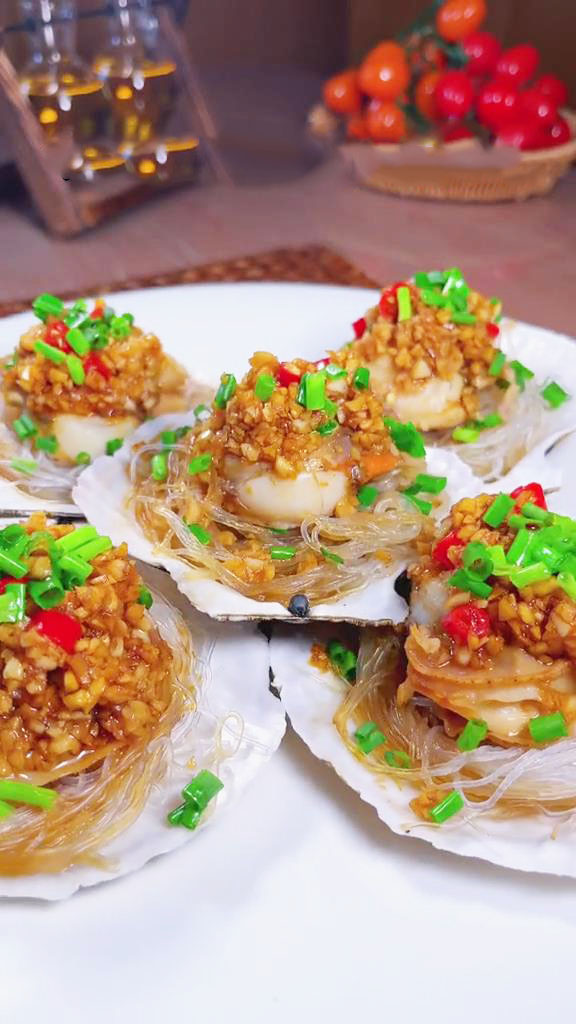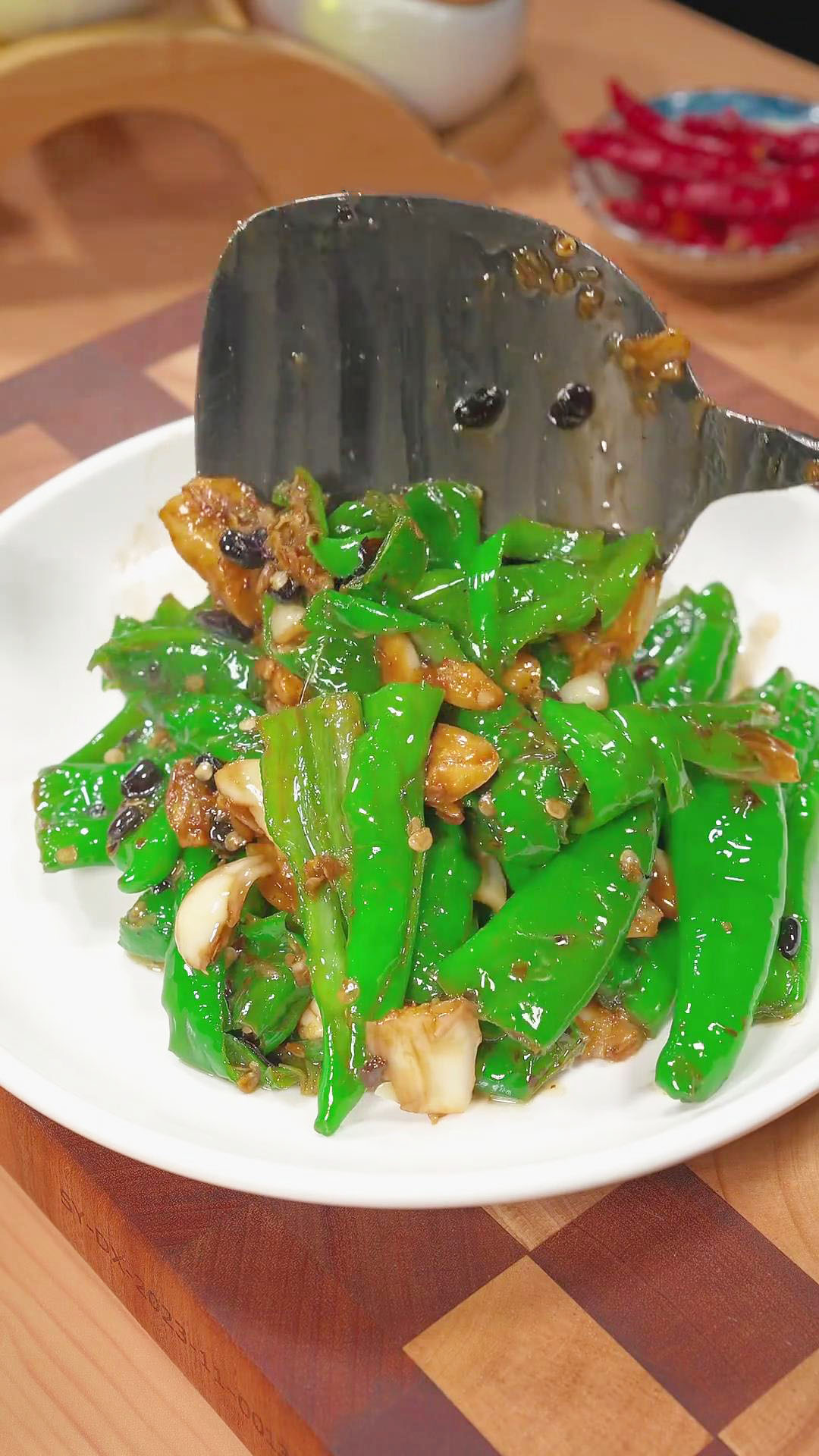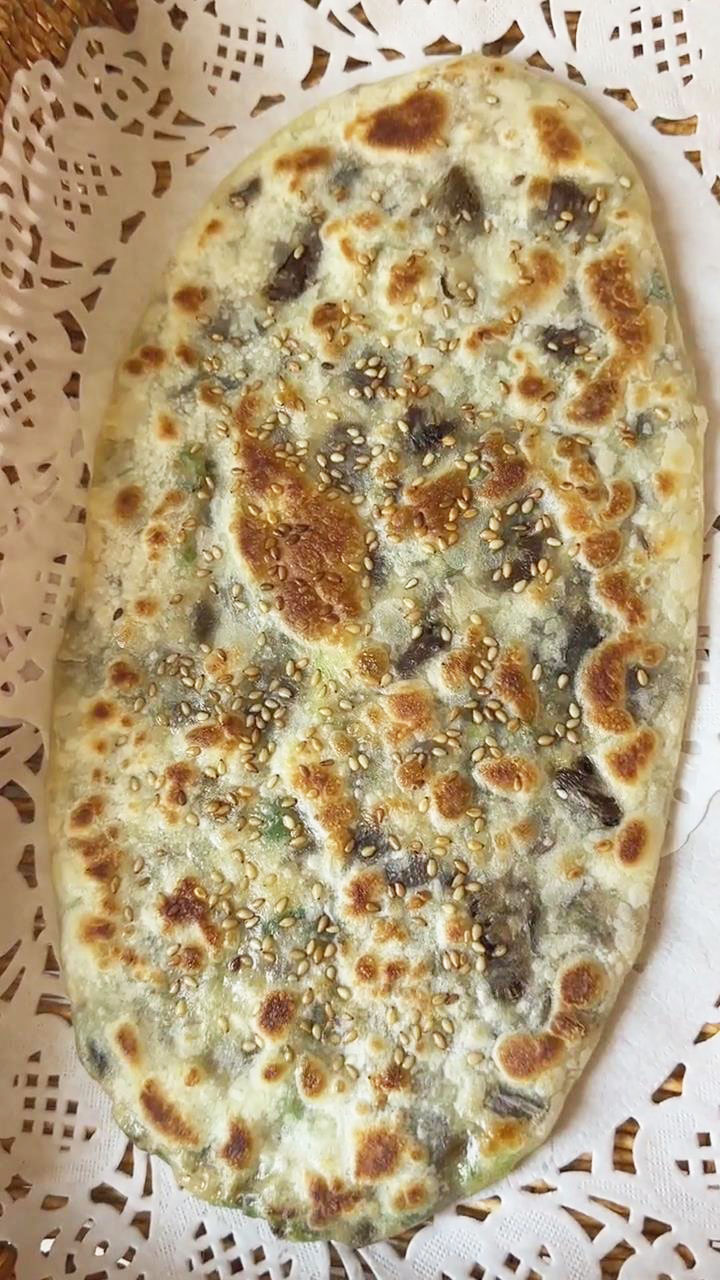This post may contain affiliate links. Please read our disclosure policy.
It is sticky, gooey, and packed with various meats and seasonings. Lo mai gai is your go-to dim sum dish for yum cha. Make this dish with glutinous rice and flavoring ingredients like chicken thighs, Chinese sausage, dried shiitake mushrooms, dried scallops, and dried shrimp, to name a few.
What Is Lo Mai Gai?
Lo mai gai or Nuo Mi Ji is also known as dim sum sticky rice chicken or glutinous rice chicken.
What makes this dish special is the seasoned glutinous rice mixed with various meats. It is usually cooked in large portions wrapped in aromatic lotus leaves.
It is the perfect dish for yum cha, a type of meal of the day in Chinese cuisine similar to brunch.
Like char siu bao, siu mai, and other dim sum classics, Lo Mai Gai is a staple dim sum dish commonly found in bamboo baskets at dim sum restaurants.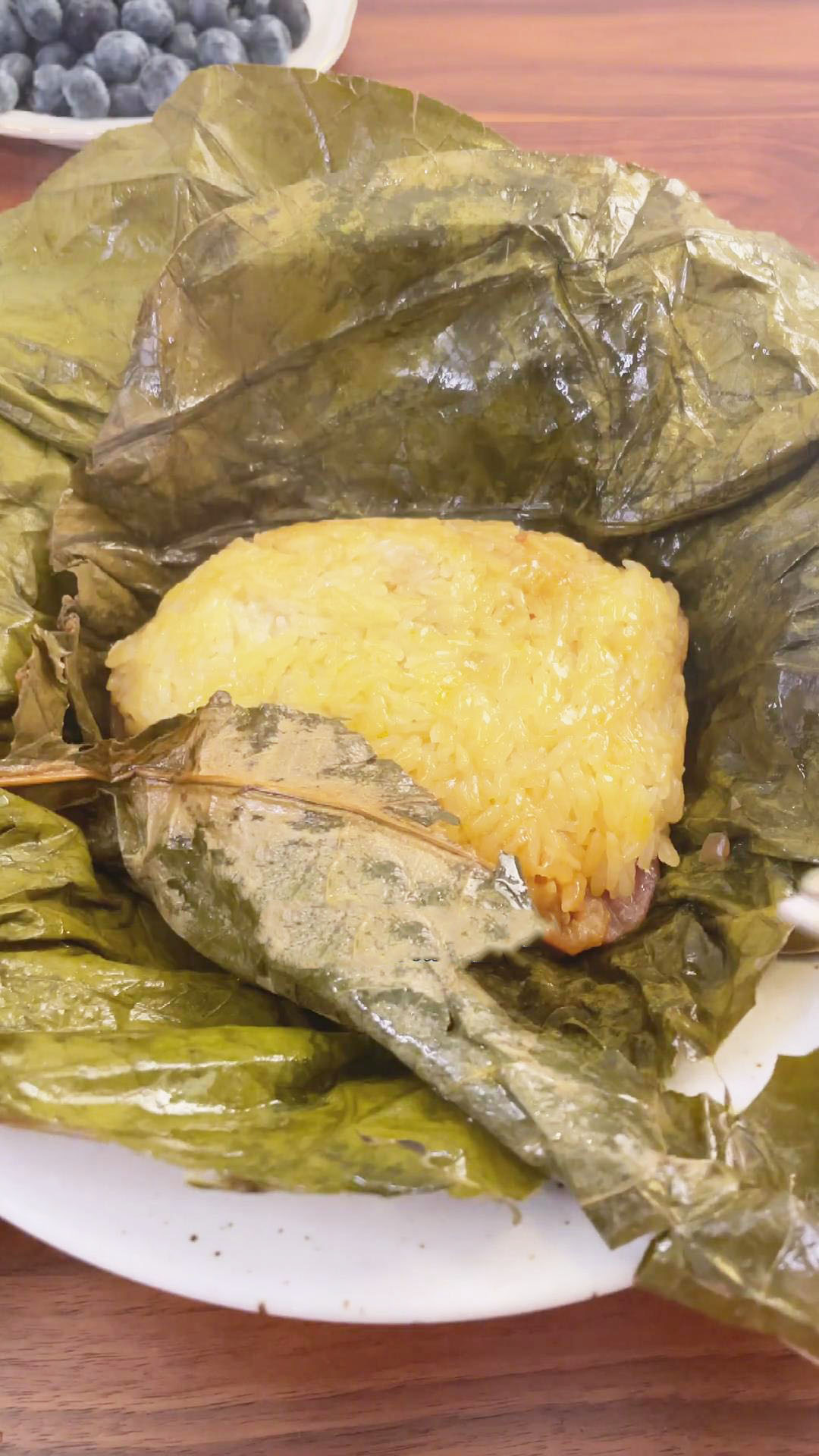
Luckily, you don’t have to eat at dim sum restaurants to have lo mai gai since you can make one yourself!
In this recipe, I cooked the glutinous rice and seasoned it with light soy sauce and peanut oil. Then, I made the meat mixture with shrimp, scallops, chicken, mushrooms, shallots, and various seasonings.
Afterward, I placed the cooked glutinous rice on the lotus leaves, spread the meat mixture on top, added salted egg yolk and Chinese sausage, and placed another flat glutinous rice on top before wrapping the leaves into a rectangle.
It is packed with flavors of various portions of meat and full of umaminess with the seasonings. Enjoy its delightful stickiness, flavorful filling, and aromatic leaves. Keep it in the fridge for 3 days or in the freezer for 3 months in an airtight container.
Zongzi VS Lo Mai Gai
Zongzi and lo mai gai are both traditional Chinese sticky rice dishes wrapped in leaves.
Zongzi consists of glutinous rice stuffed with various fillings and boiled in bamboo leaves, while lo mai gai features seasoned chicken, Chinese sausage, and mushrooms mixed with glutinous rice and steamed in lotus leaves.
The main difference lies in their ingredients and cooking methods: zongzi uses raw glutinous rice and is boiled, while lo mai gai uses precooked glutinous rice and is steamed.
Ingredient Alternatives And Suggestions
There are several ways to personalize this dish according to your taste and preference. Most of the ingredients have excellent alternatives. However, the only ingredient that I don’t recommend replacing is glutinous rice.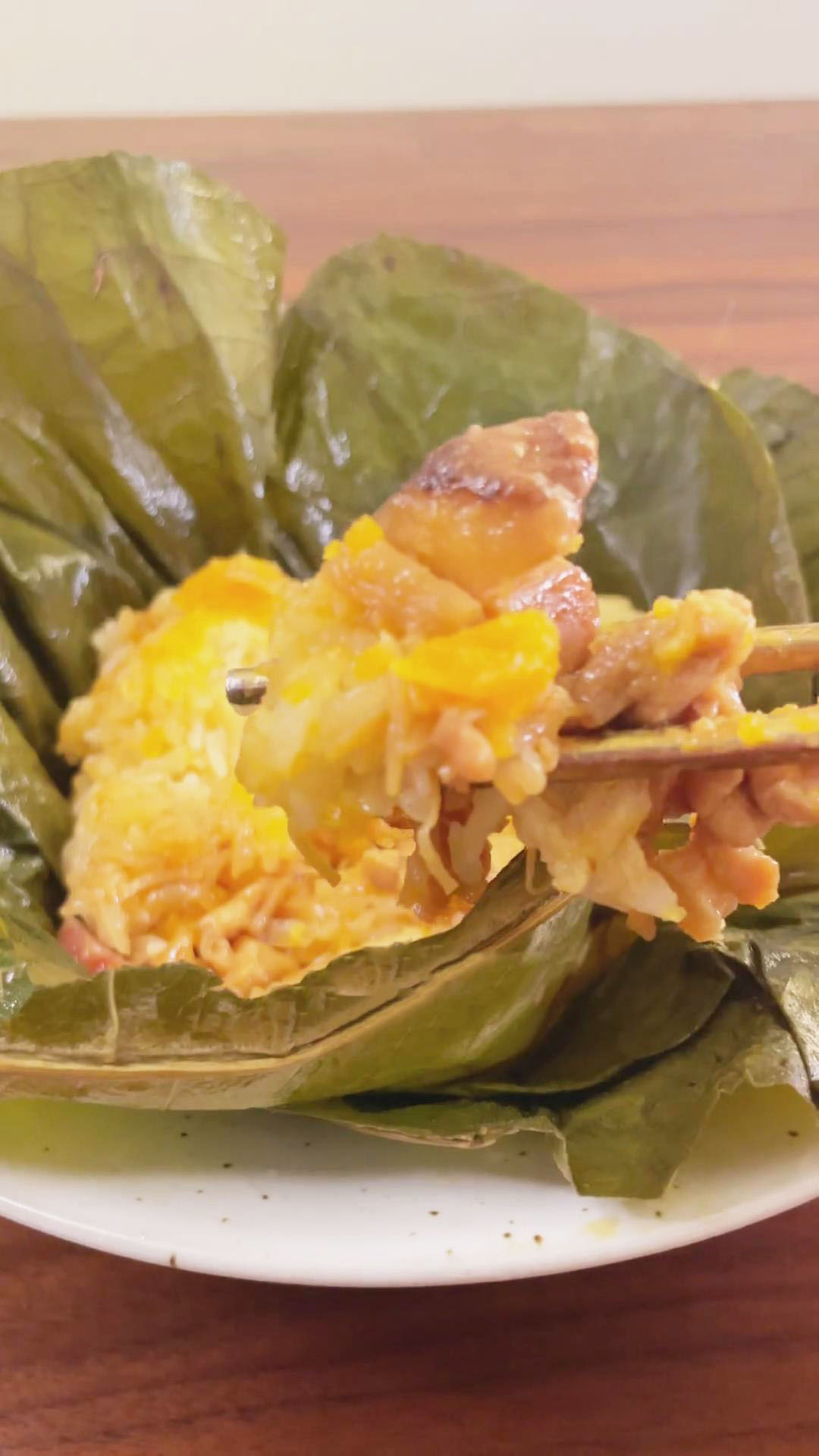
Here’s why and everything you need to know about the ingredients:
- Glutinous rice: Glutinous rice is also known as sticky rice, sushi rice, or sweet rice. Its name “glutinous” comes from the fact that it becomes glue-like and sticky when cooked, and not because it has gluten. In actuality, glutinous rice is gluten-free! It cannot be simply swapped with regular rice since it won’t yield the same sticky texture when cooked. Cook glutinous rice the same way as you cook regular rice and use the usual amount of water.
- Light soy sauce: I seasoned the glutinous rice with a bit of light soy sauce. It gives it a hint of salty and umami taste. You can use dark soy sauce as a substitute and adjust it to taste. Other types of soy sauce to consider are tamari, liquid aminos, coconut aminos, or gluten-free soy sauce.
- Peanut oil: Peanut oil is a neutral-tasting oil that won’t affect the overall taste of the rice. You will cook the rice with the peanut oil for moisture and added softness. Other neutral-tasting oils to consider are soybean and vegetable oil. For a healthier option, use olive, avocado, sesame, or safflower oil.
- Chicken: I used boneless skinless chicken thighs. You can also use chicken drumstick meat as a substitute. Basically, any type of chicken meat is fine, as long as you can chop it into bits for stir-frying.
- Chinese sausage: Chinese Sausage is also called lap cheong or lap chong. It is a type of dried and cured sausage made from seasoned pork and pork fat. It lends the rice a hint of sweet, smoky, and savory flavors. You can cut it into thin slices or cubes, fry, and combine it with rice. These are usually bought in Asian supermarkets or in the international aisle section of local grocery stores. However, I recommend making your own by following my recipe, homemade Chinese sausage. Swap this with other types of meat, such as Chinese cured pork belly, salami, pepperoni, bacon, and regular sausage.
- Salted egg yolk: You will need about 3 salted eggs and use only the yolk. Salted egg yolk lends a rich umami taste and a buttery creamy texture.
- Dried shiitake mushrooms: Dried shiitake mushrooms have a smoky and umami taste. Although fresh shiitake mushrooms have the same flavor profile, I still prefer dried shiitake since it has a stronger umami and ‘meaty’ You can replace this with other types of mushrooms, such as chopped button mushrooms, oyster mushrooms, and king oyster mushrooms.
- Dried scallops: The dried scallops are soaked before being shredded into bits. This adds a pungent and strong umami taste to the rice.
- Dried shrimp: Dried shrimp makes it briny, salty, and umami. It is pre-soaked to release more of its flavor. You can use various sizes from thumbnail size to smaller sizes. If you can’t find dried shrimp, use fresh or frozen pre-peeled shrimp.
- Lotus leaves: Dried lotus leaves are sweet with notes of bitter taste. It is aromatic with a hint of earthy tea aroma. These are usually available in Asian grocery stores. If you can’t find lotus leaves, you can replace them with these three alternatives for the purpose of wrapping:
- Parchment paper
- Banana leaves
- Steam in small bowls brushed with a little oil. Then, the bowl is flipped on a plate to serve.
- Shallots: Chopped shallots are stir-fried with shrimp, scallops, chicken, and soaked mushrooms. This type of onion has a slight sweetness to it with a hint of garlic. You can replace shallots with chopped green onions, chives, white onions, yellow onions, or red onions.
- Seasonings: After stir-frying the meat mixture, it is seasoned with light soy sauce, oyster sauce, dark soy sauce, sugar, and water.
- Dark and light soy sauce: The purpose of dark soy sauce is to impart a deeper color and thick consistency to the sauce. It is a bit sweeter than light soy sauce. On the other hand, light soy sauce is mainly for seasoning, making the sauce salty and umami.
- Oyster sauce: Oyster sauce is a combination of sweet and savory, similar to the flavors of soy sauce and barbecue sauce with a hint of caramel-like taste. Some excellent alternatives to oyster sauce are hoisin sauce, teriyaki sauce, kecap manis, Worcestershire sauce with soy sauce and sugar, oyster-flavored sauce, or fish sauce.
- Sugar: The sugar will balance out the salty flavors of oyster sauce, light soy sauce, and dark soy sauce. You can use any type of sweetener, including white sugar, cane sugar, brown sugar, maple syrup, or coconut sugar.
- Water: Water will thin out the mixture and make it less salty.
- Cornstarch slurry: After adding the sauce, I poured cornstarch slurry to make the sauce and meat mixture thick and creamy. Without cornstarch slurry, the meat mixture will only have a runny sauce that can spill from the lotus leaves. You will want the sauce to thicken to stick to the meat mixture and not be absorbed by the rice. To make the cornstarch slurry, mix 2 teaspoons of cornstarch with 3 teaspoons of water. You can also follow a 1:2 ratio (1 tbsp of cornstarch with 2 tbsp of water). If you don’t have cornstarch, you can substitute 1 tbsp of cornstarch with 2 tbsp of tapioca flour or 1 tbsp of potato starch.
- Optional flavoring ingredients: Alter the taste with more flavoring ingredients and vegetables. Here are some examples and simply adjust to taste:
- Shaoxing rice wine
- White pepper powder
- Black pepper powder
- Chinese Five Spice Powder
- Chicken bouillon
- Vegetable powder
- Sesame oil
- Bamboo shoots
- Peas
- Carrots
- Ginger
Ingredients And Kitchenware To Prepare
The first thing you need is a cooking pot or rice cooker to cook the glutinous rice. You will also need to prepare a pan for blanching the lotus leaves and stir-frying the meat and vegetables. Lastly, a steamer is recommended to steam the assembled lo mai gai.
If you don’t have a steamer, you can still steam food without a steamer in 5 ways: pan with steamer rack, microwave, pan with sieve, rice cooker, and instant pot. Aside from this kitchenware, prepare your mixing bowls, knife, chopping board, and spatula.
To make 4 Lo Mai Gai, prepare the following ingredients:
The ingredients to prepare are the following:
- 280g glutinous rice
- 2 boneless skinless chicken thighs
- 1 link of Chinese sausage
- 3 salted egg yolk
- 4 dried shiitake mushrooms
- 10 dried scallops
- 2 tablespoons dried shrimp
- 1 tsp light soy sauce
- 1 tsp peanut oil
- 8 lotus leaves
- 1/2 chopped shallots
- Seasonings:
- 2 tablespoons light soy sauce
- 1 tablespoon oyster sauce
- ½ tablespoon dark soy sauce
- 1 teaspoon white sugar
- 50ml water
- Cornstarch slurry (2 teaspoons corn starch mixed with 3 teaspoons water)
Step-By-Step Instructions To Make Lo Mai Gai
In a nutshell, you will have to cook the glutinous rice with light soy sauce and peanut oil, prepare the dried ingredients, and stir-fry the meat and vegetables with the sauce.
The last step involves assembling the rice and meat mixture with the lotus leaves before steaming. The steps may be a lot, but it will be a lot easier to follow by reading the step-by-step instructions below and watching my tutorial video on Instagram or TikTok.
When you are done making lo mai gai, share your recipe version by tagging me @kitchenmisadventures on social media. Leave a comment in the comments section to share your thoughts and ideas.
If you liked this recipe, I recommend making Rice Paper Dumplings Recipe (Gluten-Free), Tang Yuan Recipe (Black Sesame Glutinous Rice Balls), and Thai Mango Sticky Rice Dessert.
Prepare The Ingredients (Soak, Chop, Cook)
- Rehydrate the dried ingredients in hot water until soft if needed, such as the dried shiitake mushrooms, dried scallops, and dried shrimp. Then, drain the water and chop them into smaller pieces.
- Clean, dice, and marinate the chicken with salt and white pepper powder.
- Prepare the glutinous rice in a rice cooker using a rice-to-water ratio of 1:1 or 1:1.2. Mix light soy sauce and peanut oil in the water of the rice. Cook it in a rice cooker or traditional stove. Use the sweet rice setting of your rice cooker if it has one. While you can soak the glutinous rice in water for 6 hours or more for better water absorption and a tender texture, I don’t soak the glutinous rice in this recipe.
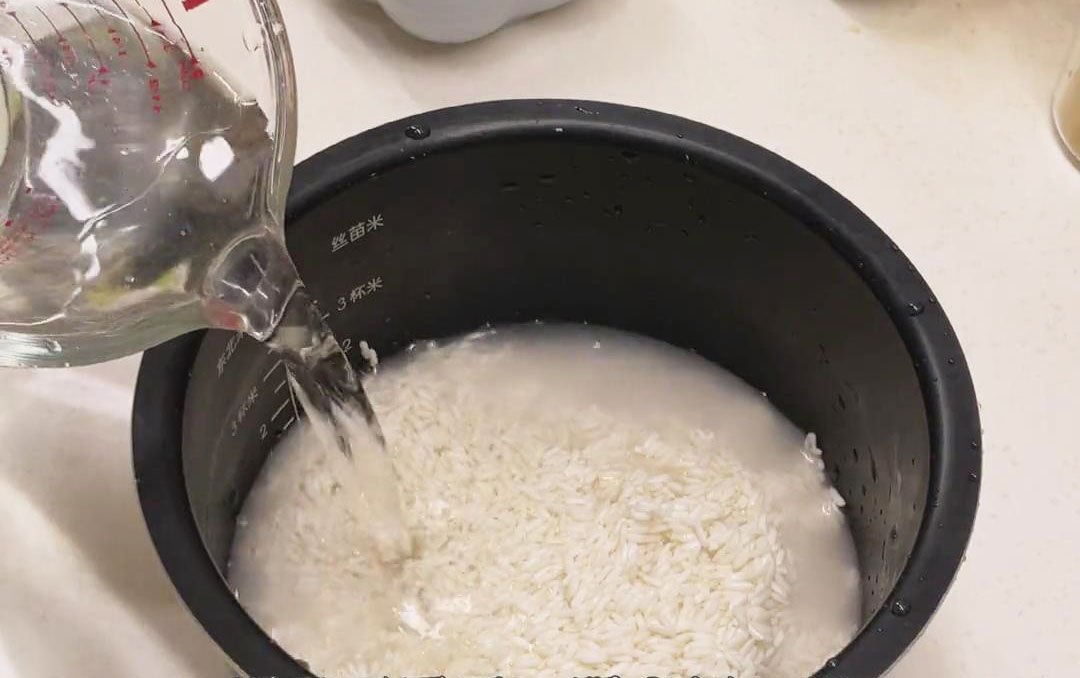
- Cook Chinese sausage and salted egg yolk for about 10 minutes. The Chinese sausage can be cooked by pan-frying, boiling, or steaming, while the salted egg yolk can be steamed. Chop the sausage into bits and set aside the salted egg yolk. For easier cooking, I suggest cooking the Chinese sausage and salted egg yolk together with the rice if your rice cooker has a steamer basket on top. In this way, you can save time in cooking and preparation since you can cook them as one.
- Prepare a pan with water and bring to a boil. Once it boils, clean the lotus leaves and blanch them in hot water for a minute or less. Drain and set aside. If the lotus leaves are too big, you can cut it in half and make a smaller piece.

Stir-Fry The Ingredients And Make The Sauce
- Prepare a pan with oil and heat it. When the oil is hot, stir-fry the chopped shrimp and scallops, diced chicken (marinated with salt and white pepper), soaked sliced mushrooms, and chopped shallots.

- In a bowl, combine light soy sauce, oyster sauce, dark soy sauce, sugar, and water to make the sauce. Mix and pour the sauce into the stir-fried ingredients in the pan.
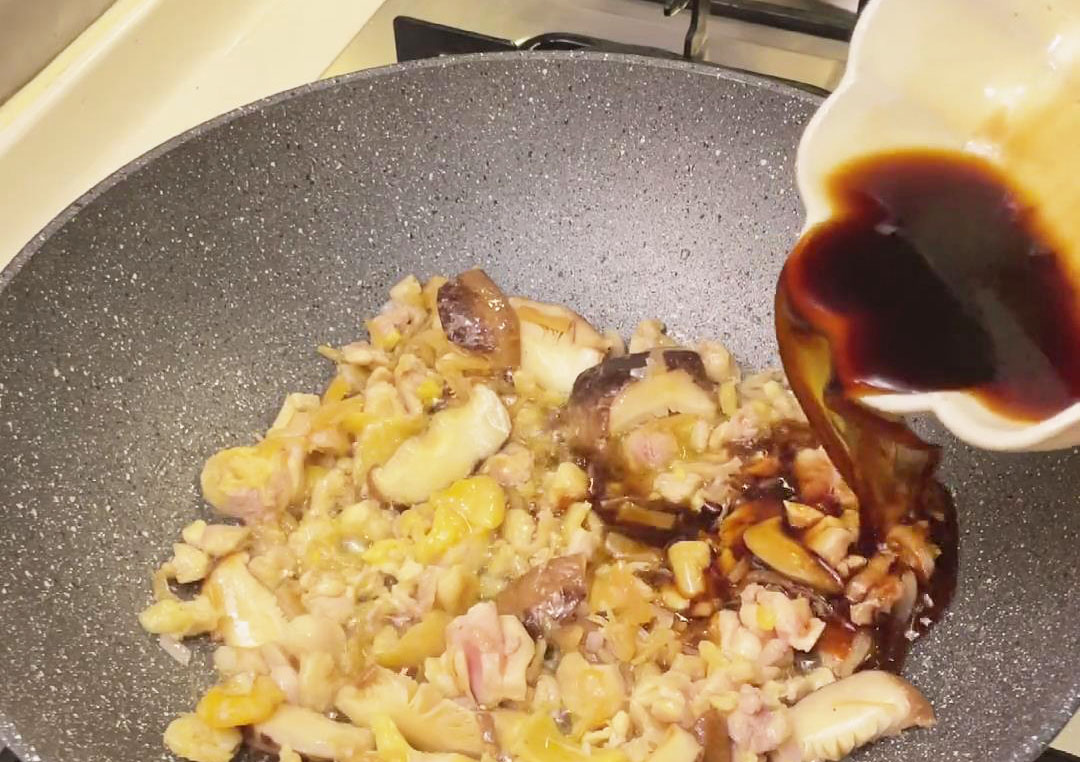
- Add cornstarch slurry (2 teaspoons of cornstarch with 3 teaspoons of water). Cook for 2 minutes until the sauce thickens. Make sure to mix the cornstarch slurry once more before cooking in the pan since the cornstarch tends to settle at the bottom.
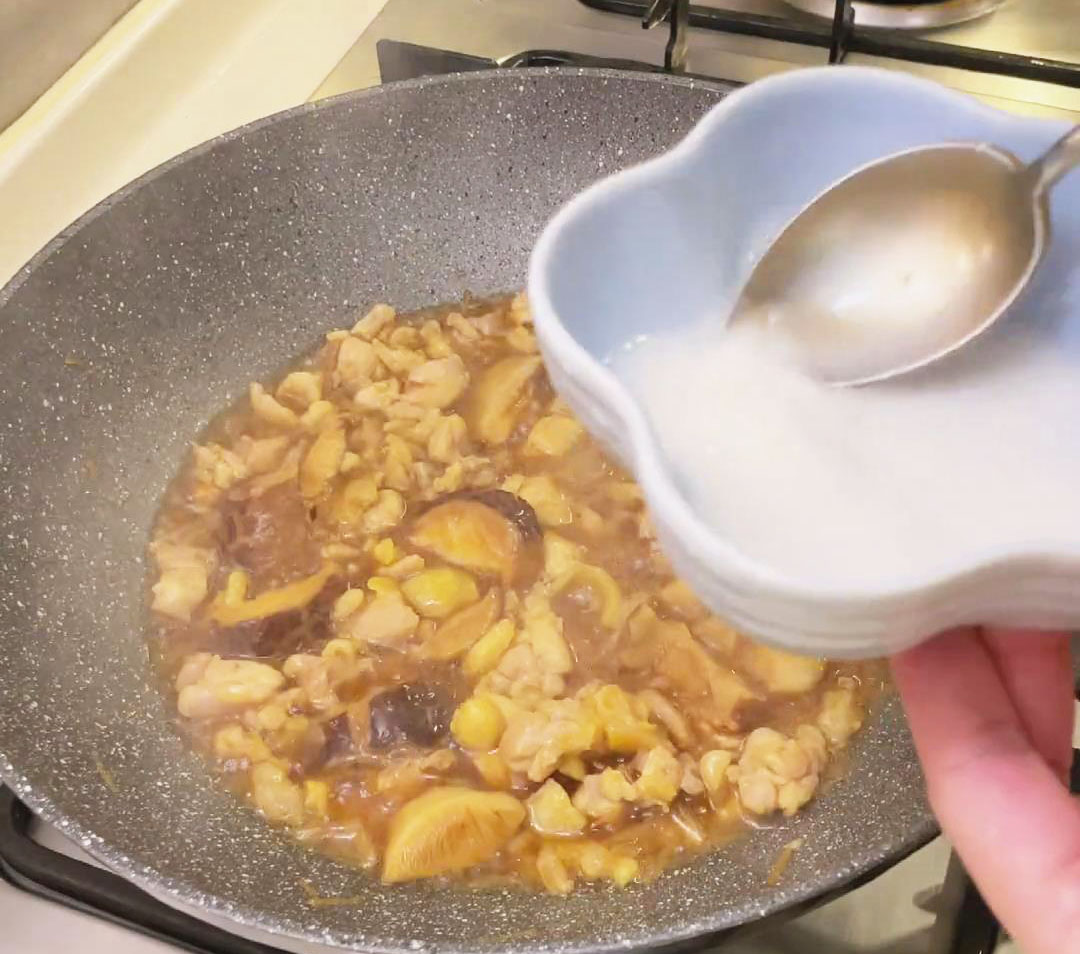
Assemble The Glutinous Rice, Meat Mixture, And Lotus Leaves
- Take the lotus leaves and wipe a bit of oil on the surface.
- Flatten the cooked glutinous rice, making an oval shape.
- Place the flattened glutinous rice on 2 pieces of lotus leaves.
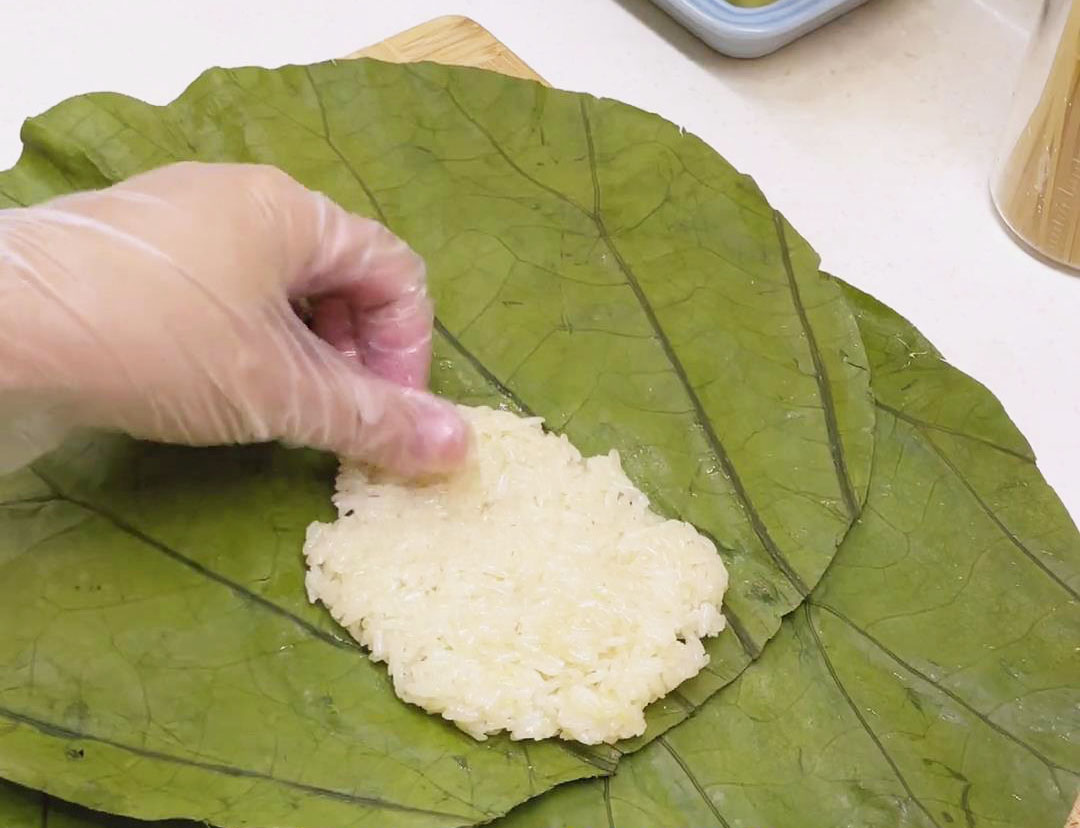
- Spread the meat mixture over the rice.
- Top it with salted egg yolk and chopped Chinese sausage.
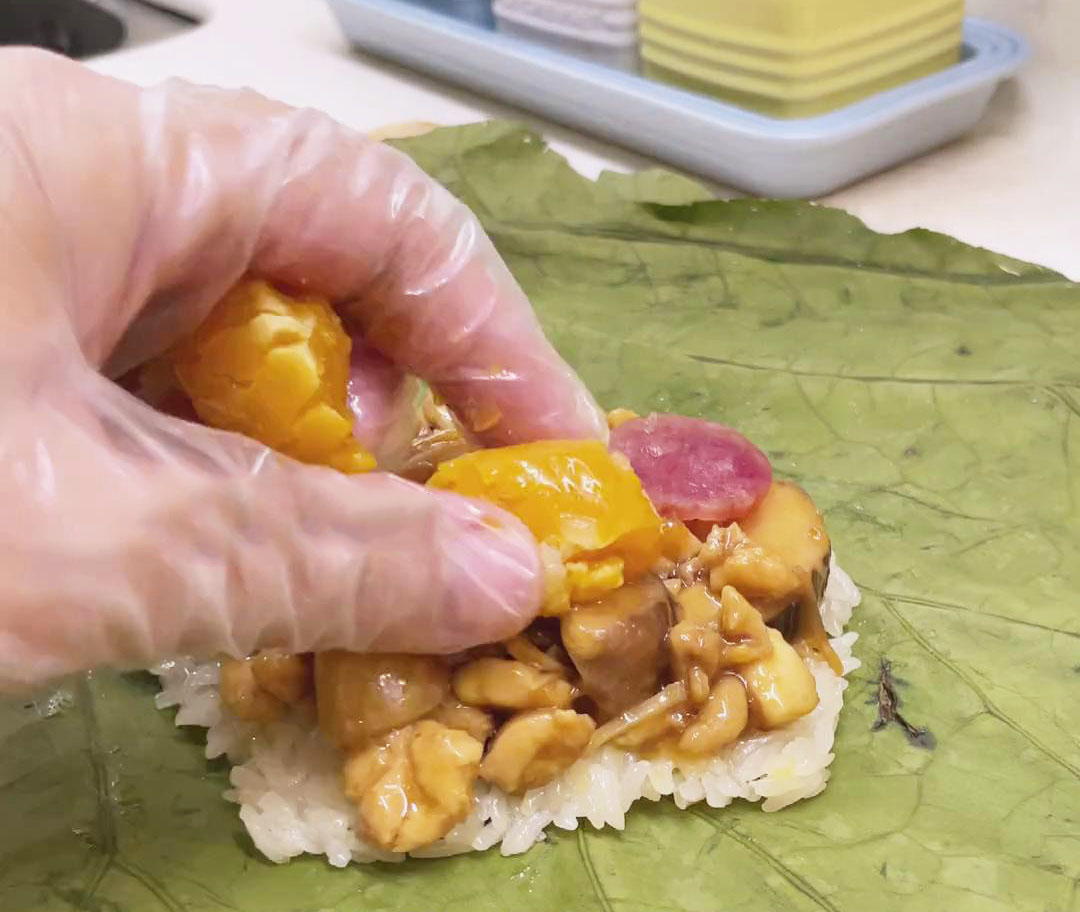
- Make another flattened glutinous rice and place it on top of the filling. Make sure the filling is sandwiched between the two flattened glutinous rice portions. It should be completely covered with rice without spilling.
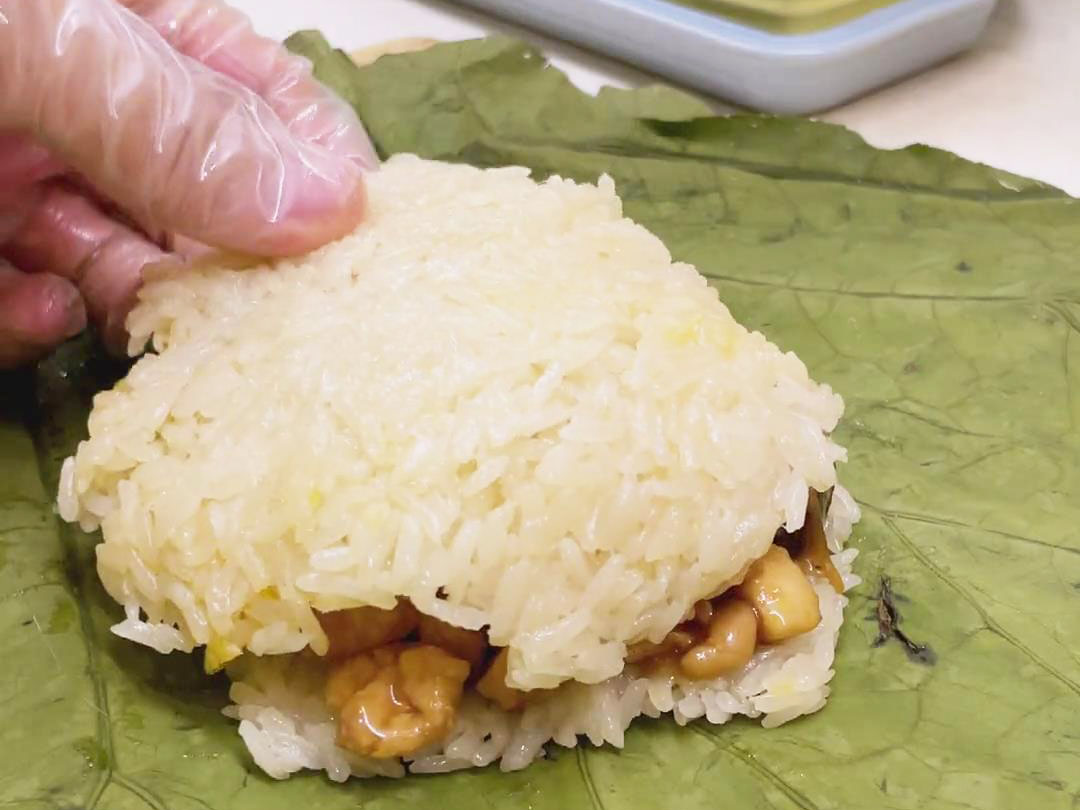
- Fold the leaves into a rectangle. Fold the top downwards, the bottom upwards, the right side to the left, and the left side to the right.
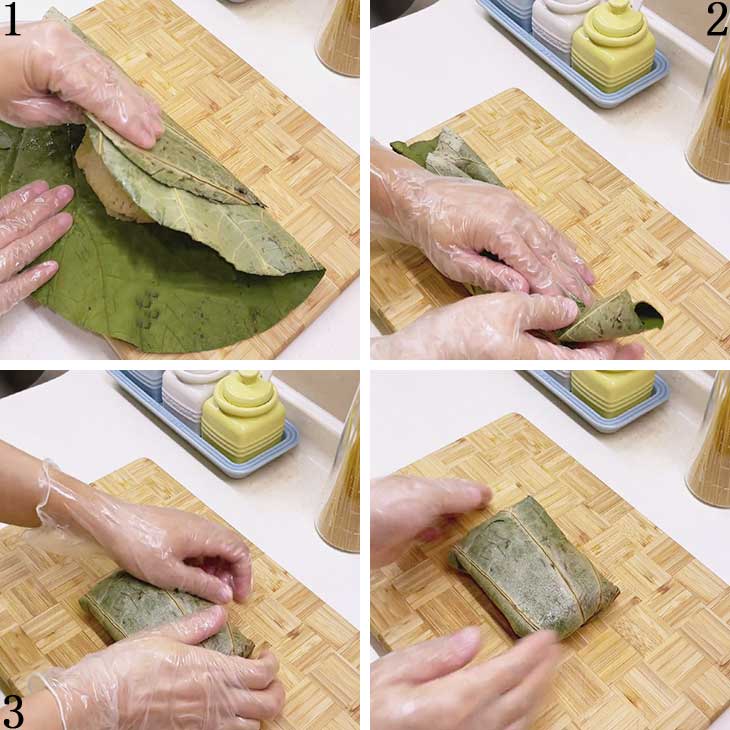
- Prepare the steamer with water. Steam the assembled lo mai gai for 20 minutes on high heat.
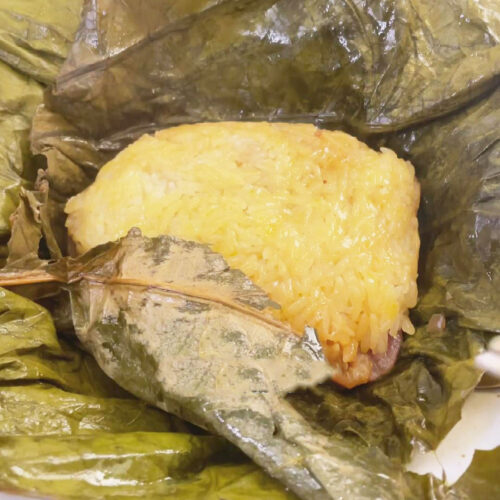
How To Make Sticky Rice Chicken
Ingredients
- 280 g glutinous rice
- 2 boneless skinless chicken thighs
- 1 link of Chinese sausage
- 3 salted egg yolk
- 4 dried shiitake mushrooms
- 10 dried scallops
- 2 tablespoons dried shrimp
- 1 tsp light soy sauce
- 1 tsp peanut oil
- 8 lotus leaves
- 1/2 chopped shallots
- 50 ml water
- Cornstarch slurry 2 teaspoons of cornstarch mixed with 3 teaspoons of water
Seasonings:
- 2 tablespoons light soy sauce
- 1 tablespoon oyster sauce
- ½ tablespoon dark soy sauce
- 1 teaspoon white sugar
Instructions
Prepare The Ingredients (Soak, Chop, Cook)
- Rehydrate the dried ingredients in hot water until soft if needed, such as the dried shiitake mushrooms, dried scallops, and dried shrimp. Then, drain the water and chop them into smaller pieces.
- Clean, dice, and marinate the chicken with salt and white pepper powder.
- Prepare the glutinous rice in a rice cooker using a rice-to-water ratio of 1:1 or 1:1.2. Mix light soy sauce and peanut oil in the water of the rice. Cook it in a rice cooker or traditional stove. Use the sweet rice setting of your rice cooker if it has one. While you can soak the glutinous rice in water for 6 hours or more for better water absorption and a tender texture, I don't soak the glutinous rice in this recipe.
- Cook Chinese sausage and salted egg yolk for about 10 minutes. The Chinese sausage can be cooked by pan-frying, boiling, or steaming, while the salted egg yolk can be steamed. Chop the sausage into bits and set aside the salted egg yolk. For easier cooking, I suggest cooking the Chinese sausage and salted egg yolk together with the rice if your rice cooker has a steamer basket on top. In this way, you can save time in cooking and preparation since you can cook them as one.
- Prepare a pan with water and bring to a boil. Once it boils, clean the lotus leaves and blanch them in hot water for a minute or less. Drain and set aside. If the lotus leaves are too big, you can cut it in half and make a smaller piece.
Stir-Fry The Ingredients And Make The Sauce
- Prepare a pan with oil and heat it. When the oil is hot, stir-fry the chopped shrimp and scallops, diced chicken (marinated with salt and white pepper), soaked sliced mushrooms, and chopped shallots.
- In a bowl, combine light soy sauce, oyster sauce, dark soy sauce, sugar, and water to make the sauce. Mix and pour the sauce into the stir-fried ingredients in the pan.
- Add cornstarch slurry (2 teaspoons of cornstarch with 3 teaspoons of water). Cook for 2 minutes until the sauce thickens. Make sure to mix the cornstarch slurry once more before cooking in the pan since the cornstarch tends to settle at the bottom.
Assemble The Glutinous Rice, Meat Mixture, And Lotus Leaves
- Take the lotus leaves and wipe a bit of oil on the surface.
- Flatten the cooked glutinous rice, making an oval shape.
- Place the flattened glutinous rice on 2 pieces of lotus leaves.
- Spread the meat mixture over the rice.
- Top it with salted egg yolk and chopped Chinese sausage.
- Make another flattened glutinous rice and place it on top of the filling. Make sure the filling is sandwiched between the two flattened glutinous rice portions. It should be completely covered with rice without spilling.
- Fold the leaves into a rectangle. Fold the top downwards, the bottom upwards, the right side to the left, and the left side to the right.
- Prepare the steamer with water. Steam the assembled lo mai gai for 20 minutes on high heat.

